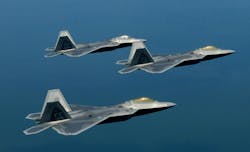Air Force makes last call to develop enabling technologies for secure airborne networking for combat jets
ROME, N.Y. – U.S. Air Force researchers are making last call for a four-year $50 million project to develop the next generation of directional low-probability-of-intercept networked aerial layer communications for high-performance combat jets.
Officials of the Air Force Research Laboratory's Information Directorate in Rome, N.Y., re-issued a broad agency announcement (FA875020S7003) on Monday for the Next-Generation Airborne Directional Networking project.
Directional communications for airborne networking enables airborne transmitters to focus most of their energy on an intended receiver. This not only resists interference and increases link capacity, but also helps safeguard signals from would-be eavesdroppers.
Tactical airborne networks often are different from mobile ad-hoc networks (MANETs), and some of these differences lend themselves to design trade-offs, researchers explain.
Compared with MANETS, tactical airborne networks are entirely vehicle based systems, which changes power consumption and equipment constraints otherwise imposed by battery operated handheld devices.
Although less severe than handheld operation, aircraft still present size, weight, power, and cost (SWAP-C) challenges as well as entirely different vibration and environmental requirements.
Different loss characteristics enable greater range, and allow any participant in the network to connect directly, which increases the threat of interference. Different altitudes and environmental conditions affect propagation of signals.
Related: Air Force asking industry for manned and unmanned adaptive self-healing airborne networks
Fast, maneuverable jet fighters require apertures and RF electronics capable of rapid switching and pointing. Airborne networks also must deal with different traffic characteristics, and diminished worst-case capacity imposed by anti-jam and low observability needs. These differences motivate a focused assessment of the trade space in directional and secure networking, researchers say.
Additional example areas of interest are topology management and scheduling; network discovery while maintaining a low probability of detection; ad-hoc network join and leave; directional routing and media access control; survivable airborne communication technologies; modular and open-architecture systems; intelligent information services; flexible directional apertures; and multi-function RF systems.
Expected funding is $15.4 million in 2022, and $7.1 million in 2023. Researchers originally expected to spend $10.4 million in 2020 and $16.9 million in 2021.
Companies interested should email white papers to the Air Force's Richard Butler at [email protected] by 3 July 2022 for 2023 consideration. Send classified white papers by post to Richard Butler care of AFRL/RITF, 525 Brook Rd., Rome, NY 13441-4505.
Email technical questions to Richard Butler at [email protected], and contractual questions to Amber Buckley at [email protected].
More information is online at https://sam.gov/opp/ccb68ebeffef411bbdc0009e02c8d960/view.

John Keller | Editor-in-Chief
John Keller is the Editor-in-Chief, Military & Aerospace Electronics Magazine--provides extensive coverage and analysis of enabling electronics and optoelectronic technologies in military, space and commercial aviation applications. John has been a member of the Military & Aerospace Electronics staff since 1989 and chief editor since 1995.

